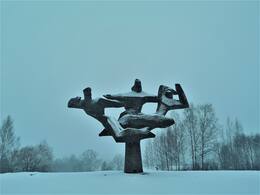On the crimes of the Red Army soldiers in Tukums.
Several monuments to the Red Army have been erected in Tukums during the Soviet occupation. Today, they have still not lost their former Soviet ideological goals and continue to create the myth of the Red Army as liberators. There are many sources for the crimes of Red Army soldiers. One group of sources can be found in local newspapers, which vividly describe the Red Army's permissiveness and the scale of the crime.
(..) In Tukums, the Red Army killed several inhabitants [..] In these days and later, the Red Army raped women on a large scale. The works of power were carried out even on girls aged 12-14 [..] The Red Army took time for passers-by on the street, and when it was said, they took the clock. For many, wedding rings have been removed, bicycles have been taken away. It often happened that a Red Army shot into the air as he entered the house and then robbed the intimidated residents. (..).
(..) Almost no houses of Tukums residents have remained unattended. Watches, valuables, vodka, jam, honey - were the main values sought by [..] The Red Army detained approx. 30 years old woman and asked: "Pakaži zubi!" The man opened his mouth with several golden teeth. Mongolia, without thinking much, broke his unfortunate mouth out of the street and left (..) "
Newspaper "Tukums news". It's gone. August 29, 1944
Related timeline
Related topics
Related objects
Monument for the Freedom-Fighters
It is located in Tukuma, Mālkalna, Jelgavas street 15A.
The monument was opened in 1975 to highlight the merits of the Red Army during World War II. It served as a means of Soviet ideology and propaganda, symbolically strengthening the presence of the occupation regime in Latvia and creating the myth of the Soviet power as "liberators". The author of the monument is sculptor and resident of Tukums Arta Dumpe...





